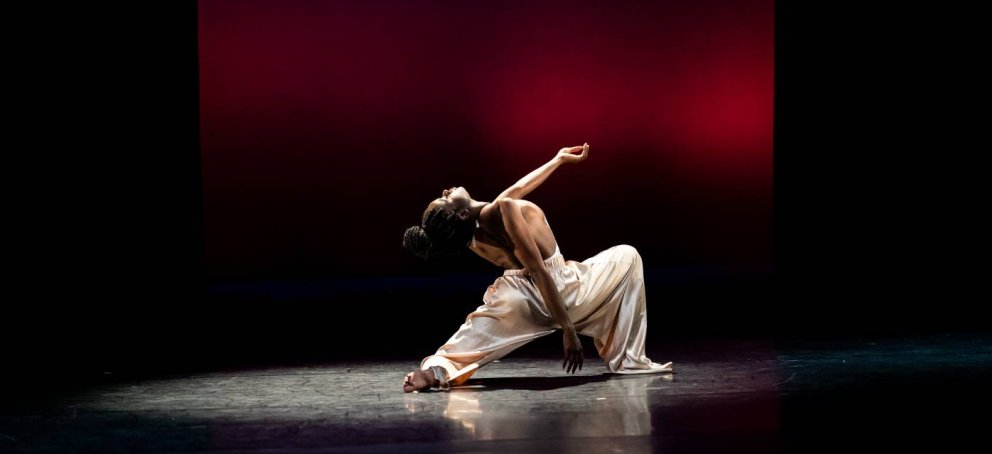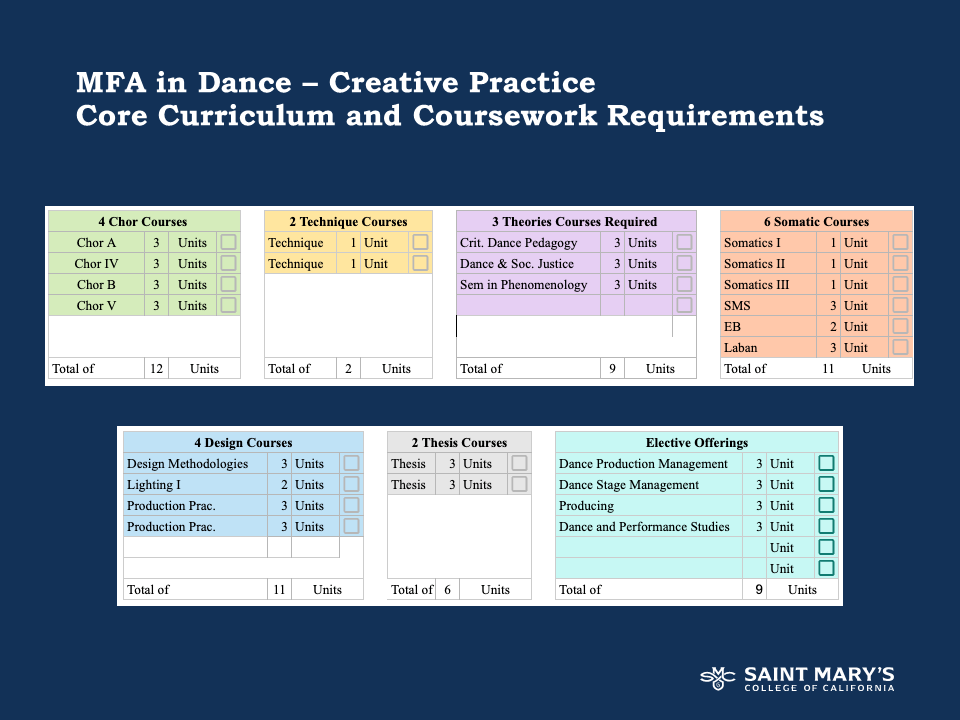Graduation Requirements

Degree Completion
Students must complete the requisite coursework to advance to M.F.A. candidacy, meet deadlines, and submit their final thesis project to ProQuest to earn their degree. Graduation requirements include the following:
1. Successful completions of all required courses totaling 60 units
2. Successful completions of thesis research paper and project
3. Completion of thesis panels
4. Thesis turned in to Proquest
______________________________________________________________________________________________
1. Successful completion of all required courses totaling 60 units
Creating your academic plan with the help of your advisor is the key for a prompt and successful completion of your course-work requirements. At the end of your last Summer Term, once all grades have been published, the Registrar will conduct a degree audit to confirm that all coursework requirements, including both components of your thesis, have been met.
2. Successful completion of thesis research paper and project
The Thesis course is the culmination of the MFA in Dance. The student’s creative process is guided and supervised by the Thesis chair assigned to them. During the last year of the MFA course of study, the student is expected to finish the two components of the Thesis project: (1) creation of the Thesis artistic work and (2) written document. Both of these Thesis elements are intended to demonstrate the knowledge and understanding gained in all the other parts of the MFA program.
3. Completion of thesis panels
After completion of the thesis presentation and final paper submission, the student will defend their work to a panel made up of program faculty and the student's Thesis Chair. The student is expected to complete their panels within a week of presenting their project.
4. Thesis upload to ProQuest
Once the final draft of your thesis document has been signed off by your Thesis Chair and other required signees, you will upload your thesis to ProQuest with assistance from the college library. You are able to order bound copies of your document through the ProQuest website.
Educating the Whole Dance Artist

Course Descriptions
Choreography A, IV and V (3 Units, In-Person)
The choreography in-person courses build upon each other to enhance the study of making dances at the graduate level. Finding individuality and a unique voice is an essential focus of inquiry. Students are guided to discover further choreographic strategies to create solo and group dances for the stage or studio, as well as for non-conventional sites. Students are asked to take risks and create challenges to enable experimentation and innovation. We highlight the value of perception over judgment, and acceptance over approval when viewing and discussing the work. Students are encouraged to freely explore movement inventions and focus on the process. Improvisation, collaboration, choreographic theory, and feedback methods will be discussed to assist in the artistic process.
Choreography B (3 Units)
This asynchronous course is designed for the student to embark on an independent creative journey focusing primarily on solo movement exploration and with emphasis on process rather than goal. The student will work on the investigation of movement using different guidelines and tools. The work developed by the student must reflect rigorous body/movement/somatic investigation and the ability of self-directed practice-based research, experimentation, reflection and reassurance of artistic identity. The creative process during the semester may influence the students’ thesis proposal, and guide the development of work that students may be required to present in future MFA concerts.
Seminar in Phenomenology (3 Units)
This Seminar style course follows foundational notions from the philosophical field of inquiry of Phenomenology to enlighten a critical view of dance and the moving body. Students discuss a variety of texts that offer unique perspectives to understand Phenomenology, definitions, history, terminology, and the approaches that have existed since the 20th century to apply this philosophical framework to dance.
Dance & Social Justice (3 units)
This course illuminates the intersection of dance, social justice and a range of human rights concerns of the twenty-first century. We acknowledge the urgency to address oppressive systems and ideologies that create oppression, violence, poverty, scarcity of resources, and fear for people around the world. We as dancers know the power and transformative nature of movement, creativity and dance to heal and transform communities, to fight oppressive systems, and to create social change and beauty in the world. In this class we work together to co-create a space for each individual student to engage in critical self-awareness through an intersectional lens, to participate in cross-cultural communication, and to begin to address systemic change through dance making practices.
Critical Dance Pedagogy (3 Units)
In this class, students engage in critical self-reflection to discover who they are as engaged educators. We build educational partnerships with one another and mentor teachers as we form critical inquiry groups to interrogate and augment our teaching practices and the beliefs that inform them. We learn how to communicate non violently and how to build restorative and deeply connected learning communities. This area of study is based on various applications of somatic movement principles to the teaching of dance following the perspective of Paulo Freire’s Critical Pedagogy, phenomenological perspectives, constructivism philosophy, liberation methodology, and transformative learning theories that inform the teaching of dance (Pedagogy, Andragogy, and Heutagogy).
Embodied Bartenieff (2 Units)
This experiential course is taught from a general perspective of somatics and is designed so the main focus is on the Body aspect of BESS (Body, Effort, Shape, and Space). Bartenieff Fundamentals℠ (BF) is studied from a broad perspective that includes connections to the developmental movement work that is proposed by other somatic modalities, particularly Body-Mind Centering® (BMC); Dynamic Embodiment™ (DE); and a branch of DE called BodyMind Dancing™ (BMD).
Somatics 1 Unit Courses
Somatics I, II and III are part of the 1 credit somatics sequence in the MFA program. These courses are primarily experiential, focusing on the student’s own movement practice. The students will meet with the instructor synchronously between 1-3 times throughout the semester, and complete the rest of the work on their own through discussion boards, journaling, videos and other asynchronous offerings. The somatics series focuses on specific somatic movement approaches such as Body-Mind Centering®; Dynamic Embodiment™; Social Somatics; Shin Somatics®; and other forms approved by ISMETA (International Somatic Movement Education and Therapy Association).
Laban and Bartenieff Movement Studies (3 units)
Laban Bartenieff Movement Studies (LBMS) is divided into four parts: Body (Bartenieff Fundamentals℠), Effort, Shape, and Space. This class examines theory, vocabulary and embodiment of all categories. Through observations, experiential explorations, reflective writing, and assessment of individual movement practices, students delve into the perspectives on human movement that LBMS provides, as well as specific applications to students’ unique interests in teaching and choreography.
Design Methodologies (3 Units)
Design Methodologies for Dance explores the underlying principles of the design process, the development of traditional design styles, and the techniques employed in developing a design. Various styles and methods are demonstrated through the lens of each area of design for dance and their development is explored with a critical view of social and historical contexts.
Lighting I (2 Units)
Lighting I is a beginning look at the methods of choreographic expression through light. This class explores the history of lighting design for dance, examining the development of design styles for varying genres through various historic and social contexts. Students explore attempts to capture, describe, define or interpret light in diverse fields such as religion, philosophy, poetry, literature, science, performance, architecture, art, installation, film and photography. After establishing common visual references, designers are guided to develop their own concepts and styles. Students hone their ability to articulate lighting ideas through visual, verbal, and written media.
West African Dance (1 Unit)
This course provides an intermediate look into the art of West African dancing as well as augmenting the necessary skills and understanding for an appreciation of the artistic, athletic, and social qualities of dance. Throughout the course, students will learn various concepts surrounding dance including music, history of dance, culture, etiquette, and application in social settings as well as stage performances.
Improv (1 Unit)
School and Department Information
Rosana Barragán
Program Director, Graduate Programs in Dance
rb7@stmarys-ca.edu
Collin Skeen
Assistant Director of Admissions and Recruitment
cas38@stmarys-ca.edu
925-631-4190